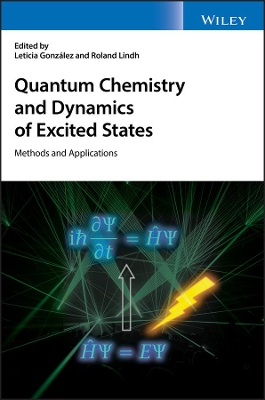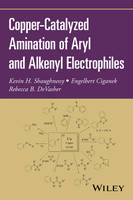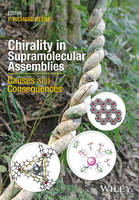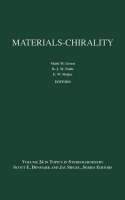Multivalency
 -15%
portes grátis
-15%
portes grátis
Multivalency
Concepts, Research and Applications
Huskens, Jurriaan; Ravoo, Bart Jan; Haag, Rainer; Prins, Leonard J.
John Wiley & Sons Inc
01/2018
416
Dura
Inglês
9781119143468
15 a 20 dias
850
Foreword xv
Preface xvii
Part I General Introduction to Multivalent Interactions 1
1 Additivity of Energy Contributions in Multivalent Complexes 3
Hans?-Jorg Schneider
1.1 Introduction 3
1.2 Additivity of Single Interactions - Examples 3
1.3 Limitations of Additivity 7
1.3.1 Free Energy Values ?G Instead of Enthalpic and Entropic Values ?H, T?S 7
1.3.2 Mismatch as Limitation of Additivity 9
1.3.3 Medium Effects as Limiting Factor 12
1.3.4 Strain and Induced Fit 12
1.4 Cooperativity 13
1.5 Allostery 14
1.6 Conclusions 17
References 18
2 Models and Methods in Multivalent Systems 23
Jurriaan Huskens
2.1 Introduction 23
2.1.1 General Introduction 23
2.1.2 Multivalent versus Cooperative Interactions 24
2.2 Numerical Data Analysis 25
2.2.1 Model Simulations Using a Spreadsheet Approach 26
2.2.2 Setting Up and Assessing Titrations 30
2.2.3 Using Spreadsheet Simulations to Fit Experimental Data to a Model 36
2.3 Models for Multivalent Systems 41
2.3.1 The Simplest Multivalent System: A 1:1 Complex with Two Interaction Sites 41
2.3.2 Multivalent Binding at Surfaces 46
2.4 Special Multivalent Systems 53
2.4.1 Increasing the Valency of Interfacial Assemblies: Dendrimers, Oligomers, and Polymers 53
2.4.2 Heterotropic Interactions 58
2.4.3 Kinetics and Dynamics 63
2.5 Conclusions 68
Acknowledgments 68
References 68
3 Design Principles for Super Selectivity using Multivalent Interactions 75
Tine Curk, Jure Dobnikar, and Daan Frenkel
3.1 Introduction 75
3.1.1 Background: Ultra?-sensitive Response 75
3.2 Super Selectivity: An Emergent Property of Multivalency 78
3.3 Multivalent Polymer Adsorption 84
3.4 Which Systems are Super Selective? 86
3.4.1 Rigid Geometry Interactions 86
3.4.2 Disordered Multivalency 87
3.5 Design Principles for Super?-Selective Targeting 90
3.6 Summary: It is interesting, but is it useful? 93
Appendix 3.A: What Is Effective Molarity? 95
Acknowledgements 98
References 98
4 Multivalency in Biosystems 103
Jens Dernedde
4.1 Introduction 103
4.2 Cell-Cell Adhesion 104
4.2.1 Homotypic Interactions, Cadherins Keep Cells Together 105
4.2.2 Selectins, Heterotypic Cell Adhesion to Fight Infections 106
4.2.3 Bacterial Adhesion by FimH 108
4.3 Phase Transition, Multivalent Intracellular Assemblies 109
4.4 Multivalency in the Fluid Phase, Pathogen Opsonization 111
4.5 Conclusion 113
Acknowledgment 113
References 114
Part II Multivalent Systems in Chemistry 121
5 Multivalency in Cyclodextrin/Polymer Systems 123
Akihito Hashidzume and Akira Harada
5.1 Introduction 123
5.2 General Perspectives of Multivalency in Cyclodextrin/Polymer Systems 125
5.3 Typical Examples of Multivalency in Cyclodextrin/Polymer Systems 126
5.3.1 Formation of Polymer Aggregates from Cyclodextrin?-Polymers and Guest?-Polymers 126
5.3.2 Selectivity of Interaction Enhanced by Multivalency 127
5.3.3 Self?-Healable Hydrogels Based on Multivalency 134
5.4 Summary and Outlook 136
Acknowledgments 136
References 138
6 Cucurbit[n-uril?-Mediated Multiple Interactions 143
Zehuan Huang and Xi Zhang
6.1 Introduction to Cucurbit[n-uril Chemistry 143
6.2 Heteroternary Complexes 143
6.3 Homoternary Complexes 146
6.4 Conclusions 150
References 150
7 Multivalency as a Design Criterion in Catalyst Development 153
Paolo Scrimin, Maria A. Cardona, Carlos M. Leon Prieto, and Leonard J. Prins
7.1 Introduction 153
7.2 Formation of Enzyme?-Like Catalytic Pockets 154
7.3 Cooperativity Between Functional Groups 157
7.4 Mechanistic Effects 161
7.5 The Dendritic Effect in Multivalent Nanozymes 164
7.5.1 Peptide?-Based Dendrimers for the Cleavage of Phosphodiesters 166
7.5.2 Catalytic 3D SAMs on Au NPs 168
7.6 Multivalent Catalysts and Multivalent Substrates 170
7.7 Conclusions 172
Acknowledgements 174
References 174
8 Multivalent Molecular Recognition on the Surface of Bilayer Vesicles 177
Jens Voskuhl, Ulrike Kauscher, and Bart Jan Ravoo
8.1 Introduction 177
8.2 Molecular Recognition of Vesicles 179
8.2.1 Metal Coordination 180
8.2.2 Light Responsive Interactions 184
8.2.3 Hydrogen Bonding and Electrostatic Interactions 185
8.3 Biomimetic Vesicles 188
8.3.1 Vesicles as Multivalent Platforms 188
8.3.2 Membrane Fusion 193
8.4 Vesicle?-based Supramolecular Materials 196
8.4.1 Hydrogels 196
8.4.2 Immobilization of Vesicles 198
8.4.3 Nanoparticles and Nanocontainers 198
8.5 Conclusion 201
Acknowledgment 201
References 201
Part III Multivalent Systems in Biology 205
9 Blocking Pathogens by Multivalent Inhibitors 207
Sumati Bhatia, Benjamin Ziem, and Rainer Haag
9.1 Introduction 207
9.2 Design of Multivalent Ligand Architectures 209
9.3 Multivalent Carbohydrate Ligands 212
9.4 Scaffold Architecture 215
9.4.1 Linear and Dendritic Scaffolds 215
9.4.2 Multivalent Gold Nanoparticles 218
9.4.3 2D Platforms 220
9.5 Nano?-and Microgels for Pathogen Inhibition 222
9.6 Conclusion 223
Acknowledgments 224
References 224
10 Multivalent Protein Recognition Using Synthetic Receptors 229
Akash Gupta, Moumita Ray, and Vincent M. Rotello
10.1 Introduction 229
10.2 Structural Properties of Protein Surfaces 229
10.2.1 Protein-Protein Interfacial Areas 229
10.2.2 Chemical Nature of the Protein-Protein Interface 230
10.2.3 "Hot Spots" 230
10.2.4 O?-Ring Structure 232
10.3 Synthetic Receptors for Protein Surface Recognition 232
10.3.1 Porphyrin Scaffolds for Protein Surface Recognition 232
10.3.2 Protein Surface Recognition Using Molecular Tweezers 238
10.3.3 Calixarene Scaffolds for Protein Surface Recognition 240
10.3.4 Recognition of Protein Surfaces Using Nanoparticles 243
10.3.4.1 Nanoparticles as Protein Mimics 244
10.3.4.2 Regulating the Structure and Function of Proteins Using Nanoparticles 246
10.3.4.3 Nanoparticle?-based Protein Sensors 250
10.4 Future Perspective and Challenges 254
Acknowledgment 257
References 257
11 Multivalent Calixarenes for the Targeting of Biomacromolecules 263
Francesco Sansone and Alessandro Casnati
11.1 Introduction 263
11.2 Binding to Proteins and Enzymes 266
11.3 Recognition of Carbohydrate Binding Proteins (Lectins) 273
11.4 Binding Polyphosphates, Oligonucleotides and Nucleic Acids 279
11.5 Conclusions 284
Acknowledgements 285
References 285
12 Cucurbit[n]uril Assemblies for Biomolecular Applications 291
Emanuela Cavatorta, Luc Brunsveld, Jurriaan Huskens, and Pascal Jonkheijm
12.1 Introduction 291
12.2 Molecular Recognition Properties of CB[n- 293
12.2.1 Interactions with the Carbonyl Portals of CB[n- 293
12.2.2 Release of High Energy Water Molecules from the CB[n- Cavity 295
12.2.3 Enthalpy?-driven Hydrophobic Effect for CB[n- 295
12.2.4 Enthalpy?-driven Hydrophobic Effect for CB[8- Heteroternary Complexes 297
12.3 Control Over the Binding Affinity with CB[n- 299
12.4 CB[n] Recognition of Amino Acids, Peptides, and Proteins 301
12.5 CB[n] for Bioanalytical and Biomedical Applications 305
12.5.1 CB[n]-mediated Assembly of Bioactive Polymers and Hydrogels 305
12.5.2 CB[n]-mediated Assembly of Bioactive Nanoparticles 307
12.5.3 CB[n]?-mediated Assembly on Bioactive Surfaces 313
12.6 Conclusions and Outlook 317
Acknowledgment 319
References 319
13 Multivalent Lectin-Glycan Interactions in the Immune System 325
Joao T. Monteiro and Bernd Lepenies
13.1 Introduction 325
13.2 Targeting Innate Immunity to Shape Adaptive Immunity 327
13.3 C?-type Lectin Receptors 328
13.3.1 Multivalent Glycoconjugates Targeting DC?-SIGN 331
13.3.2 Multivalent Glycoconjugates Targeting Other CLRs 331
13.4 Galectins 332
13.5 Siglecs 334
13.6 Conclusions 335
Acknowledgment 335
References 335
14 Blocking Disease Linked Lectins with Multivalent Carbohydrates 345
Marjon Stel and Roland J. Pieters
14.1 Introduction 345
14.2 Haemagglutinin 347
14.3 LecA 349
14.4 LecB 354
14.5 Galectins 358
14.6 Concanavalin A 362
14.7 Cholera Toxin 366
14.8 Propeller Lectins 367
14.9 Conclusion 371
Acknowledgements 371
References 371
Index 381
Foreword xv
Preface xvii
Part I General Introduction to Multivalent Interactions 1
1 Additivity of Energy Contributions in Multivalent Complexes 3
Hans?-Jorg Schneider
1.1 Introduction 3
1.2 Additivity of Single Interactions - Examples 3
1.3 Limitations of Additivity 7
1.3.1 Free Energy Values ?G Instead of Enthalpic and Entropic Values ?H, T?S 7
1.3.2 Mismatch as Limitation of Additivity 9
1.3.3 Medium Effects as Limiting Factor 12
1.3.4 Strain and Induced Fit 12
1.4 Cooperativity 13
1.5 Allostery 14
1.6 Conclusions 17
References 18
2 Models and Methods in Multivalent Systems 23
Jurriaan Huskens
2.1 Introduction 23
2.1.1 General Introduction 23
2.1.2 Multivalent versus Cooperative Interactions 24
2.2 Numerical Data Analysis 25
2.2.1 Model Simulations Using a Spreadsheet Approach 26
2.2.2 Setting Up and Assessing Titrations 30
2.2.3 Using Spreadsheet Simulations to Fit Experimental Data to a Model 36
2.3 Models for Multivalent Systems 41
2.3.1 The Simplest Multivalent System: A 1:1 Complex with Two Interaction Sites 41
2.3.2 Multivalent Binding at Surfaces 46
2.4 Special Multivalent Systems 53
2.4.1 Increasing the Valency of Interfacial Assemblies: Dendrimers, Oligomers, and Polymers 53
2.4.2 Heterotropic Interactions 58
2.4.3 Kinetics and Dynamics 63
2.5 Conclusions 68
Acknowledgments 68
References 68
3 Design Principles for Super Selectivity using Multivalent Interactions 75
Tine Curk, Jure Dobnikar, and Daan Frenkel
3.1 Introduction 75
3.1.1 Background: Ultra?-sensitive Response 75
3.2 Super Selectivity: An Emergent Property of Multivalency 78
3.3 Multivalent Polymer Adsorption 84
3.4 Which Systems are Super Selective? 86
3.4.1 Rigid Geometry Interactions 86
3.4.2 Disordered Multivalency 87
3.5 Design Principles for Super?-Selective Targeting 90
3.6 Summary: It is interesting, but is it useful? 93
Appendix 3.A: What Is Effective Molarity? 95
Acknowledgements 98
References 98
4 Multivalency in Biosystems 103
Jens Dernedde
4.1 Introduction 103
4.2 Cell-Cell Adhesion 104
4.2.1 Homotypic Interactions, Cadherins Keep Cells Together 105
4.2.2 Selectins, Heterotypic Cell Adhesion to Fight Infections 106
4.2.3 Bacterial Adhesion by FimH 108
4.3 Phase Transition, Multivalent Intracellular Assemblies 109
4.4 Multivalency in the Fluid Phase, Pathogen Opsonization 111
4.5 Conclusion 113
Acknowledgment 113
References 114
Part II Multivalent Systems in Chemistry 121
5 Multivalency in Cyclodextrin/Polymer Systems 123
Akihito Hashidzume and Akira Harada
5.1 Introduction 123
5.2 General Perspectives of Multivalency in Cyclodextrin/Polymer Systems 125
5.3 Typical Examples of Multivalency in Cyclodextrin/Polymer Systems 126
5.3.1 Formation of Polymer Aggregates from Cyclodextrin?-Polymers and Guest?-Polymers 126
5.3.2 Selectivity of Interaction Enhanced by Multivalency 127
5.3.3 Self?-Healable Hydrogels Based on Multivalency 134
5.4 Summary and Outlook 136
Acknowledgments 136
References 138
6 Cucurbit[n-uril?-Mediated Multiple Interactions 143
Zehuan Huang and Xi Zhang
6.1 Introduction to Cucurbit[n-uril Chemistry 143
6.2 Heteroternary Complexes 143
6.3 Homoternary Complexes 146
6.4 Conclusions 150
References 150
7 Multivalency as a Design Criterion in Catalyst Development 153
Paolo Scrimin, Maria A. Cardona, Carlos M. Leon Prieto, and Leonard J. Prins
7.1 Introduction 153
7.2 Formation of Enzyme?-Like Catalytic Pockets 154
7.3 Cooperativity Between Functional Groups 157
7.4 Mechanistic Effects 161
7.5 The Dendritic Effect in Multivalent Nanozymes 164
7.5.1 Peptide?-Based Dendrimers for the Cleavage of Phosphodiesters 166
7.5.2 Catalytic 3D SAMs on Au NPs 168
7.6 Multivalent Catalysts and Multivalent Substrates 170
7.7 Conclusions 172
Acknowledgements 174
References 174
8 Multivalent Molecular Recognition on the Surface of Bilayer Vesicles 177
Jens Voskuhl, Ulrike Kauscher, and Bart Jan Ravoo
8.1 Introduction 177
8.2 Molecular Recognition of Vesicles 179
8.2.1 Metal Coordination 180
8.2.2 Light Responsive Interactions 184
8.2.3 Hydrogen Bonding and Electrostatic Interactions 185
8.3 Biomimetic Vesicles 188
8.3.1 Vesicles as Multivalent Platforms 188
8.3.2 Membrane Fusion 193
8.4 Vesicle?-based Supramolecular Materials 196
8.4.1 Hydrogels 196
8.4.2 Immobilization of Vesicles 198
8.4.3 Nanoparticles and Nanocontainers 198
8.5 Conclusion 201
Acknowledgment 201
References 201
Part III Multivalent Systems in Biology 205
9 Blocking Pathogens by Multivalent Inhibitors 207
Sumati Bhatia, Benjamin Ziem, and Rainer Haag
9.1 Introduction 207
9.2 Design of Multivalent Ligand Architectures 209
9.3 Multivalent Carbohydrate Ligands 212
9.4 Scaffold Architecture 215
9.4.1 Linear and Dendritic Scaffolds 215
9.4.2 Multivalent Gold Nanoparticles 218
9.4.3 2D Platforms 220
9.5 Nano?-and Microgels for Pathogen Inhibition 222
9.6 Conclusion 223
Acknowledgments 224
References 224
10 Multivalent Protein Recognition Using Synthetic Receptors 229
Akash Gupta, Moumita Ray, and Vincent M. Rotello
10.1 Introduction 229
10.2 Structural Properties of Protein Surfaces 229
10.2.1 Protein-Protein Interfacial Areas 229
10.2.2 Chemical Nature of the Protein-Protein Interface 230
10.2.3 "Hot Spots" 230
10.2.4 O?-Ring Structure 232
10.3 Synthetic Receptors for Protein Surface Recognition 232
10.3.1 Porphyrin Scaffolds for Protein Surface Recognition 232
10.3.2 Protein Surface Recognition Using Molecular Tweezers 238
10.3.3 Calixarene Scaffolds for Protein Surface Recognition 240
10.3.4 Recognition of Protein Surfaces Using Nanoparticles 243
10.3.4.1 Nanoparticles as Protein Mimics 244
10.3.4.2 Regulating the Structure and Function of Proteins Using Nanoparticles 246
10.3.4.3 Nanoparticle?-based Protein Sensors 250
10.4 Future Perspective and Challenges 254
Acknowledgment 257
References 257
11 Multivalent Calixarenes for the Targeting of Biomacromolecules 263
Francesco Sansone and Alessandro Casnati
11.1 Introduction 263
11.2 Binding to Proteins and Enzymes 266
11.3 Recognition of Carbohydrate Binding Proteins (Lectins) 273
11.4 Binding Polyphosphates, Oligonucleotides and Nucleic Acids 279
11.5 Conclusions 284
Acknowledgements 285
References 285
12 Cucurbit[n]uril Assemblies for Biomolecular Applications 291
Emanuela Cavatorta, Luc Brunsveld, Jurriaan Huskens, and Pascal Jonkheijm
12.1 Introduction 291
12.2 Molecular Recognition Properties of CB[n- 293
12.2.1 Interactions with the Carbonyl Portals of CB[n- 293
12.2.2 Release of High Energy Water Molecules from the CB[n- Cavity 295
12.2.3 Enthalpy?-driven Hydrophobic Effect for CB[n- 295
12.2.4 Enthalpy?-driven Hydrophobic Effect for CB[8- Heteroternary Complexes 297
12.3 Control Over the Binding Affinity with CB[n- 299
12.4 CB[n] Recognition of Amino Acids, Peptides, and Proteins 301
12.5 CB[n] for Bioanalytical and Biomedical Applications 305
12.5.1 CB[n]-mediated Assembly of Bioactive Polymers and Hydrogels 305
12.5.2 CB[n]-mediated Assembly of Bioactive Nanoparticles 307
12.5.3 CB[n]?-mediated Assembly on Bioactive Surfaces 313
12.6 Conclusions and Outlook 317
Acknowledgment 319
References 319
13 Multivalent Lectin-Glycan Interactions in the Immune System 325
Joao T. Monteiro and Bernd Lepenies
13.1 Introduction 325
13.2 Targeting Innate Immunity to Shape Adaptive Immunity 327
13.3 C?-type Lectin Receptors 328
13.3.1 Multivalent Glycoconjugates Targeting DC?-SIGN 331
13.3.2 Multivalent Glycoconjugates Targeting Other CLRs 331
13.4 Galectins 332
13.5 Siglecs 334
13.6 Conclusions 335
Acknowledgment 335
References 335
14 Blocking Disease Linked Lectins with Multivalent Carbohydrates 345
Marjon Stel and Roland J. Pieters
14.1 Introduction 345
14.2 Haemagglutinin 347
14.3 LecA 349
14.4 LecB 354
14.5 Galectins 358
14.6 Concanavalin A 362
14.7 Cholera Toxin 366
14.8 Propeller Lectins 367
14.9 Conclusion 371
Acknowledgements 371
References 371
Index 381












